|
|
 |
|
September 30, 2013
The results are in and the fifth annual Sommelier Challenge had a decidedly
international flair. Six countries are represented in the Best of Show awards.
The competition was staged over the final weekend of September in San Diego,
with 16 exceptional sommeliers from around the nation evaluating 898 wines.
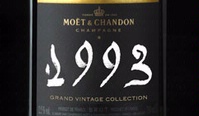
Wine of the Year
&
Best of Show Sparkling
Wine
Moet & Chandon 1993 Grand Vintage Collection Brut,
$140
Epernay, France
Best of Show Red
Wine
Castello di Gabbiano 2009 Chianti Classico Riserva DOCG,
$22
Tuscany, Italy
&
Black Stallion 2010 Cabernet Sauvignon,
$27.99
Napa Valley, California
Best of Show White
Wine
Dr. Konstantin Frank 2012 Riesling Reserve, $25
Finger
Lakes, New York
Best of Show Rose Wine
Falkner
Winery 2012 Rosato, Estate, $15.95
Temecula Valley,
California
Best of Show Dessert
Wine
Barboursville Vineyard 2008 Malvaxia Reserve Passito,
$31.99
Virgina
&
Inniskillin 2008 Riesling Icewine, VQA,
$80
Niagara Peninsula, Canada
Best of Show Fortified
Wine
Taylor Fladgate 20-Year-Old Aged Tawny, $54.99
Douro
Valley, Portugal
Best of Show Spirit
Pilavas
Tentura Liqueur, $24
Greece
Complete Results
An insider, Maurice DiMarino of the Cohn Restaurant Group, shares his perspective as a judge at Sommelier Challenge V.
Posted by Robert Whitley at 2:16 PM
|
|
September 26, 2013
The James Molesworth blog over at WineSpectator.com takes a stab at film criticism, throwing a
wet blanket on Somm, the film that documents the quest of four sommeliers
leading up to the challenging Master Sommelier exam.
 To be fair, the
subhead on the Molesworth blog called his a "minority" opinion, for the film has
generally played to enthusiastic audiences and has a good buzz simply by word of
mouth. What I liked about Somm was the very personal, very human element of the
four subjects. To be fair, the
subhead on the Molesworth blog called his a "minority" opinion, for the film has
generally played to enthusiastic audiences and has a good buzz simply by word of
mouth. What I liked about Somm was the very personal, very human element of the
four subjects.
The film was technical enough without being so geeky that casual wine
drinkers would flee the theatre in bewilderment. What everyone got from the film
was a sense of the dedication required to pass the difficult Master Somm exam.
The preparation is gruelling and many wonderful sommeliers do it and fail. Again
and again.
I found the film inspiring, but I work closely with somms in the course of
doing my job, and I respect their professionalism. Too bad James Molesworth
didn't see it that way.
Posted by Robert Whitley at 10:44 AM
|
|
September 25, 2013
Over on the reviews page I'm very upbeat on the Dutton Goldfield 2011 Freestone
Hill Pinot Noir, from what was a disaster of a vintage for most Pinot producers
in the region. This vineyard is planted in the Salmon Creek sub-region of the
Russian River Valley and it's a tremendous example of the strides California --
particularly the Russian River Valley -- has made with Pinot Noir.
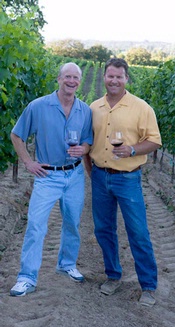 It is accepted wisdom that the finest Pinots in America come from
Oregon, and for most of the past three decades that was true. I no longer
believe that to be the case, although I confess a fondness for Drouhin Oregon,
Archery Summit and The Four Graces. It is accepted wisdom that the finest Pinots in America come from
Oregon, and for most of the past three decades that was true. I no longer
believe that to be the case, although I confess a fondness for Drouhin Oregon,
Archery Summit and The Four Graces.
But no one in America is doing better work with Pinot than winemakers Gary
Farrell at Alysian and Dan Goldfield at Dutton Goldfield. These two denizens of
the Russian River Valley have consistently earned my highest marks for domestic
Pinot Noir over the past couple of vintages. Throw Merry Edwards into the mix
and you have a veritable Murderers' Row of Pinot Noir prowess.
I still have great respect for Oregon Pinot, although a recent sampling of a
dozen different Oregon producers was hugely disappointing, and recognize that
other zones in California -- Santa Barbara County, Carneros and Monterey's Santa
Lucia Highlands -- are producing commendable Pinots, but my sense is the Russian
River Valley has gained the upper hand in this all-important wine category.
Photo: Steve Dutton and winemaker Dan Goldfield of Dutton Goldfield.
Posted by Robert Whitley at 1:04 PM
|
|
September 10, 2013
Bordeaux, arguably the epicenter of the modern wine universe, wasn't always a hot destination for wine tourism. Unlike the Napa Valley, with its two major roadways that run parallel past most of the important wineries, the Bordeaux region is a vast area surrounding the port city of Bordeaux along the Gironde, the largest estuary in Europe.
The city itself is a challenge to navigate and until recently was fairly drab and uninviting.
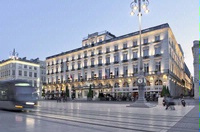 In recent years, however, the city of Bordeaux has experienced a renaissance of sorts, with a new tram system that makes getting around a breeze, and a stretch of pedestrian-only streets in the city center that has become a magnet for tourists drawn to the area's trendy restaurants and shops. In recent years, however, the city of Bordeaux has experienced a renaissance of sorts, with a new tram system that makes getting around a breeze, and a stretch of pedestrian-only streets in the city center that has become a magnet for tourists drawn to the area's trendy restaurants and shops.
I was reminded of this by a recent query from a reader concerning travel to Bordeaux. Harvest is already underway in many sections of the Bordeaux district, the heavy scent of fermenting grapes in the air being an attraction in and of itself.
When I visit Bordeaux, I have my own approach, which I am happy to share.
First, a visitor must decide whether to stay in the city and visit the chateaux of Bordeaux on day trips or take to the countryside and bunk at a cozy inn. There are advantages to staying in the city. There is nightlife, for one thing, and no shortage of excellent restaurants.
The finest hotel in the city is The Grand, smack in the center of the city with a tram stop right in front. If money is no object, this is the place to stay. On the other hand, if you are on a budget, as I am when I travel, the nearby Hotel de Normandie is an upscale three-star (out of five) property that is charming and convenient.
The Normandie is a mere two blocks from The Grand and it's just across the street from a tram stop. When I feel the need to connect with the opulence of The Grand, I simply walk across the plaza and visit over a glass of wine at The Grand bar.
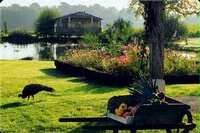 Both hotels are relatively close to the rustic La Tupina, one of the most famous restaurants in southwest France. La Tupina has no Michelin stars, but it is renowned for its traditional cuisine, typically hearty meat dishes roasted or grilled over a wood fire. The wine list at La Tupina is superb. If you only have one night for dinner in the city of Bordeaux, La Tupina is the place to go. Both hotels are relatively close to the rustic La Tupina, one of the most famous restaurants in southwest France. La Tupina has no Michelin stars, but it is renowned for its traditional cuisine, typically hearty meat dishes roasted or grilled over a wood fire. The wine list at La Tupina is superb. If you only have one night for dinner in the city of Bordeaux, La Tupina is the place to go.
Staying in the city is a good idea when the itinerary calls for flexibility, as in going south and east of the city one day to visit Graves or Saint-Emilion and north and west another day to take in Pauillac or Margaux.
Staying in the countryside has its own set of advantages, though it cuts down on the flexibility of your itinerary. Wine lovers interested in the chateaux of the Medoc region would do well to book a room at Chateau Cordeillan-Bages, a Relais & Chateaux property in Pauillac. For one thing, the kitchen, under the direction of Chef Jean-Luc Rocha, has two Michelin stars.
And the location positions you for visits to most of the top first-growth and super second-growth chateaux of Bordeaux.
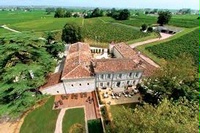 Fans of white Bordeaux, or Bordeaux blanc and Sauternes, might prefer to take up temporary residence in the opposite direction, booking a room at Les Sources de Caudalie, a luxurious spa across the street from Chateau Smith Haut Lafitte in Pessac-Leognan. The restaurant at Caudalie, La Grand Vigne, has one Michelin star. Fans of white Bordeaux, or Bordeaux blanc and Sauternes, might prefer to take up temporary residence in the opposite direction, booking a room at Les Sources de Caudalie, a luxurious spa across the street from Chateau Smith Haut Lafitte in Pessac-Leognan. The restaurant at Caudalie, La Grand Vigne, has one Michelin star.
From there a thirsty wine tourist can easily reach many of the finest producers of Saturernes and Barsac, the sweet dessert wine of Bordeaux, as well some of the legendary red-and-white wine producers of the region, such as Chateau Haut Brion, Domaine de Chevalier and Pape Clement.
Last but not least, whenever my schedule permits, I try to squeeze in a visit to the "right bank" village of Saint-Emilion, perhaps the most picturesque wine hamlet to be found anywhere in the world. This district of Bordeaux borders the commune of Pomerol, and together the two wine districts produce some of the world's most expensive and sought-after wines (Chateau Petrus, Chateau Cheval Blanc and Chateau Ausone, for example).
There is no restaurant in Saint-Emilion that I am aware of with a Michelin star, but the village is not lacking for excellent casual bistros and wine bars. When visiting Saint-Emilion, the relais at Chateau Franc Mayne is a charming and convenient location, right on the edge of the village, for an overnight stay. Best of all, the wines of Franc Mayne are modestly priced for Bordeaux and downright delicious.
Photos from the top: The Grand Hotel de Bordeaux, Les Sources de Caudalie, Chateau Franc Mayne.
Posted by Robert Whitley at 2:37 PM
|
|
September 7, 2013
Having just weathered a warm and muggy Labor Day grilling experience, I have a few thoughts on keeping your wines cool and serving them at the right temperature through the remaining dog days of summer.
As the temps soared over the Labor Day weekend, I was reminded of my many trips to France and Italy in the middle of summer. Most restaurants in the countryside lacked air conditioning and the idea of sipping wine at "room" temperature was seldom appealing.
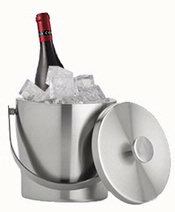 I always asked for an ice bucket, even for the red wines. A red wine off the rack in a restaurant where the ambient temperature approaches 90 F is going to taste out of balance. The tannins will be more astringent and the alcohol hotter than if the wine were served at a temperature closer to 65 F. I always asked for an ice bucket, even for the red wines. A red wine off the rack in a restaurant where the ambient temperature approaches 90 F is going to taste out of balance. The tannins will be more astringent and the alcohol hotter than if the wine were served at a temperature closer to 65 F.
Chilling your bottle of red for 10 minutes in an ice bucket will do wonders for the wine, diminishing the feel of alcohol on the palate and bringing up the fruit (as counterintuitive as that may seem). At home, I typically store wine in a refrigerated wine cabinet that maintains a steady 60 F. In warm weather, I bring the wine out about 30 minutes before serving. By the time it goes into the glass, it is near the perfect temperature for sipping.
In cooler weather, I remove reds from the refrigerated unit at least two hours prior to serving and generally decant.
White wines in warm weather pose a different challenge. Getting them cold enough to enjoy and keeping the chill on the bottle are necessary to preserve the freshness of acidity and liveliness of flavor that would be inherent in otherwise normal conditions.
I often see restaurant servers place white wines on the table without offering a means to keep the wine chilled. That works in December in the northern hemisphere but not so much in July, August or early September.
 The ice bucket is your friend in this situation for two very important reasons. First, many whites are simply not cold enough when presented in a restaurant. And if you're at home or dining al fresco, that bottle of white often comes right off the rack at the ambient room temperature. The ice bucket is your friend in this situation for two very important reasons. First, many whites are simply not cold enough when presented in a restaurant. And if you're at home or dining al fresco, that bottle of white often comes right off the rack at the ambient room temperature.
The quickest way to chill a bottle of white wine is to immerse it in ice water for 15 to 20 minutes.
If you merely set the bottle on top of the ice, or even wedge it down slightly in the bucket, the time it takes to chill throughout could more than double. This is especially crucial when chilling a sparkling wine. It is important to chill the bubbly in the neck of the bottle lest the first glass come out dull and insipid.
Second, even if a white wine is served at the perfect temperature, in warmer weather it will warm quickly at tableside. The ice bucket or an insulated wine sleeve will preserve the chill and keep the wine tasting crisp and refreshing.
Posted by Robert Whitley at 3:12 PM
|
|
 |
|